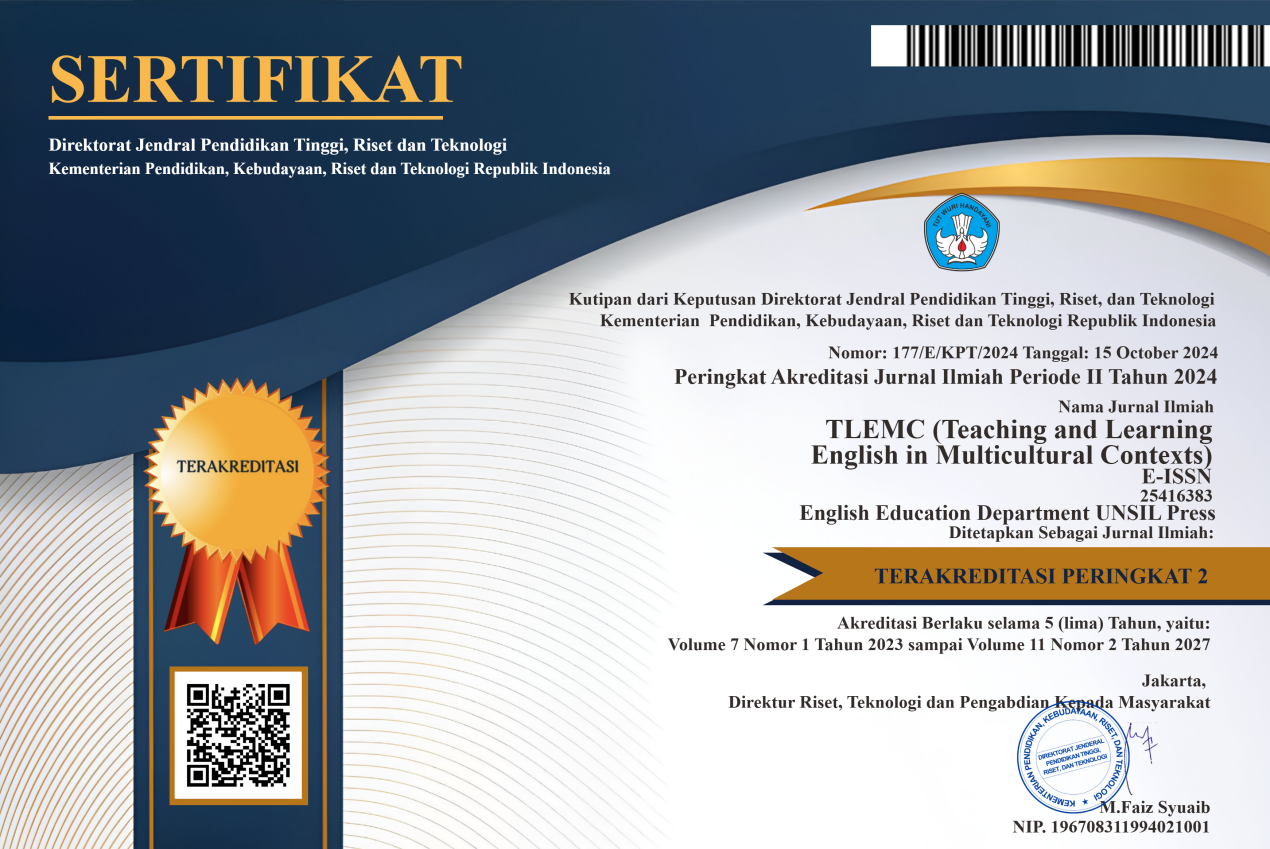The use of Target Language in a Classroom: Focusing on an Indonesian EFL Teacher
Abstract
The employment of Target Language (hereafter, TL) in English language teaching practices has burgeoned significantly. One of the reasons generating such an issue is the notion of providing students (non-native English students) sufficient exposures of English. Conversely, little is known about how English as the TL is deployed as a medium of instruction and communication among teachers and students, notably in the Indonesian junior high school remains under-researched. Hence, this study aimed at scrutinizing such an investigative issue. The participant was a female English teacher applying English as a medium of communication and instruction in the classroom learning practices. The data were garnered through non-participant observations and analyzed thematically (Braun & Clarke, 2006). The findings outlined that utilizing the target language in pre- and post- activities and commanding the student by using the target language become an obvious picture of how the TL is used as a medium of instruction and communication among teachers and students. Pedagogically speaking, encouraging students to communicate in the TL (English) enables them to generate their willingness to communicate in the TL and language awareness of the significance of TL in the classroom learning practices.  Â
Full Text:
PDFReferences
Abdullah, F., & Lulita. (2018). Social actors in an intercultural communication classroom: A discursive lens of intercultural education. IJELT, 13(1), 31–51.
Abdullah, F., Tandiana, S. T., & Amelia, R. (2020). Storybird-Based Narrative Writing Activities among Indonesian EFL Learners: Focusing on Contributions. Premise: Journal of English Education and Applied Linguistics, 9(2), 164-182.
Andriani, A., & Abdullah, F. (2017). Invigorating the EFL students in acquiring new linguistic knowledge: Language learning through projects. A Paper Presented in the 4th International Language and Language Teaching Conference in Sanata Dharma University. Yogyakarta, Nov 2017, 1–15.
Baker, C. (1988). Key issues in bilingualism and bilingual education (Vol. 35). England: Multilingual Matters.
Bateman, B.E. (2008). Student teachers’ attitudes and beliefs about using the target language in the classroom. Foreign language annals, 41(1), 11-28.
Baxter, P., & Jack, S. (2008). Qualitative case study methodology: Study design and implementation for novice researchers. The Qualitative Report, 13(4), 544-559. Retrieved from https://nsuworks.nova.edu/tqr/vol13/iss4/2
Braun, V., & Clarke, V. (2006). Using thematic analysis in psychology. Qualitative research in psychology, 3(2), 77-101.
Brown, S. (2006). Teaching listening. Cambridge: Cambridge University Press.
Cook, V. (2007). 2. Multi-Competence: Black Hole or Wormhole for Second Language Acquisition Research?. In Understanding second language process (pp. 16-26). Multilingual Matters.
Coste, D. (1997). Alternances didactiques. Études de linguistique appliquée, 393.
Crandall, J. (1997). Collaborate and cooperate. A Journal for the Teacher of English outside the United States, 35, 2.
Creswell, J. W. (2012). Educational research: Planning, conducting, and evaluating quantitative and qualitative research (4th ed.). Upper Saddle River, NJ: Pearson Education.
Dearden, J. (2014). English as a medium of instruction-a a growing global phenomenon. London: British Council.
Dickson, P. (1996). Using the target language: A view from the classroom. Slough: Nfer.
Dörnyei, Z. (1994). Motivation and motivating in the foreign language classroom. Modern Language Journal, 78(3), 273-284.
Eriksson, A. (2019). Target language use during English lessons for young language learners (Unpublished Thesis), University of Gavle, Sweden.
Fauziati, E. (2017). Native and target language influence on the students’ interlanguage production: a case of Indonesian EFL compositions. Indonesian Journal of Applied Linguistics, 7(1), 54-63.
Gardner-Chloros, P. (2009). Code-Switching. Cambridge: Cambridge University Press.
Hidayati, A. N., Dewi, N. S. N., Nurhaedin, E., & Rosmala, D. (2020). Foreign Language Listening Anxiety in an Academic Listening Class. J-SHMIC: Journal of English for Academic, 7(2), 1-9. DOI: https://doi.org/10.25299/jshmic.2020.vol7(2).5241.
Ibrahim, J. (2001). The implementation of EMI (English medium instruction) in Indonesian universities: Its opportunities, its threats, its problems, and its possible solutions. k@ ta, 3(2), 121-138.
Idris, S. (2014). Language policy and the construction of national and ethnic identities in Indonesia. US-China Education Review, 4(10), 691-705.
Karvonen, H. (2017). English as a medium of instruction benefits and challenges as viewed by founders of international schools in Ethiopia (Unpublished M.A. Thesis), University of Turku, Turku, Finland.
Krashen, S. D. (1982). Principle and practice in second language acquisition. New York: Pergamon Press.
Krashen, S. D. (1985). The input hypothesis: Issues and implications. New York: Longman.
Macaro, E. (1997). Target language, collaborative learning, and autonomy (Vol. 5). England: Multilingual Matters.
Macdonald, C. (1993). Using the target language. London: Mary Glasgow.
Mason, J. (2002). Qualitative researching (2nd ed.). Thousand Oaks, CA: Sage.
Mikhaleva, L. V., & Régnier, J. C. (2014). A parallel study of native and target-language cultures in foreign language teaching. Procedia-Social and Behavioral Sciences, 154, 118-121.
Pinter, A. (2017). Teaching young language learners. Oxford: Oxford University Press.
Rahmadani, D. (2016). Students' perception of English as a medium of instruction (EMI) in English classrooms. Journal on English as a Foreign Language, 6(2), 131-144.
Sharma, V. K., & Mittal, N. (2016). Exploiting parallel sentences and cosine similarity for identifying target language translation. Procedia Computer Science, 89, 428-433.
Tandiana, S.T., Abdullah, F. & U. Komara. (2017). Digital writing tools: Teaching argumentative essays beyond the traditional frontiers. Proceedings of the Tenth Conference on Applied Linguistics and the Second English Language the First International Conference on Language, Literature, Culture, and Education, Nov 2017 (pp. 336-343). Bandung: Balai Bahasa, Universitas Pendidikan Indonesia.
Tandiana, S. T., Abdullah, F., Komara, U., (2018). Talk- Write: A groundbreaking technique for shaping the students’ argumentative writing skills on discussion essays. EEAL Journal (English Education and Applied Linguistics Journal), 1(1), 1-9.
Tholin, J. (1992). Att lära sig lära-engelska: Om elevplanerad undervisning. Almqvist & Wiksell.
Turnbull, M., & Lamoureux, S. (2001). L1 and L2 use in core French: A focus on pre-service students' views and classroom practice. In the annual meeting of the Canadian Association of Applied Linguistics, Québec.
Yin, R., K. (2003). Case study research: Design and methods (3rd Eds.). Thousand Oaks, CA: Sage.
DOI: https://doi.org/10.37058/tlemc.v5i1.2163
Refbacks
- There are currently no refbacks.
INDEXED BY:
This work is licensed under a Creative Commons Attribution-NonCommercial-ShareAlike 4.0 International License.
![]()
TLEMC (Teaching and Learning English in Multicultural Contexts)
Program Studi Pendidikan Bahasa Inggris
Fakultas Keguruan dan Ilmu Pendidikan
Universitas Siliwangi
Jl. Siliwangi No. 24 Kota Tasikmalaya - 46115
email: tlemc@unsil.ac.id





